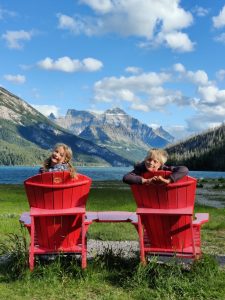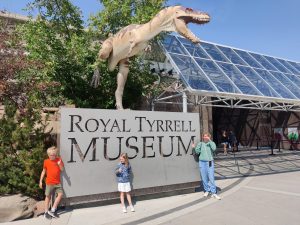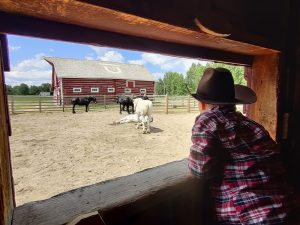 So we finally arrived at the foot of the Rocky Mountains but the weather forecasts were looking really awful. Luckily we have the luxury of having the time to wait. So instead of moving into the mountains at Banff National Park we threw the planning in the bin and manoeuvred around the bad weather. Luckily Southern Alberta has plenty of interesting stuff to keep us (and the kids) busy.
So we finally arrived at the foot of the Rocky Mountains but the weather forecasts were looking really awful. Luckily we have the luxury of having the time to wait. So instead of moving into the mountains at Banff National Park we threw the planning in the bin and manoeuvred around the bad weather. Luckily Southern Alberta has plenty of interesting stuff to keep us (and the kids) busy.
 The region of Alberta holds so many dinosaurs remains that scientists have decided to no longer excavate a lot of them and leave them in their final resting places. We visited the region of Drumheller to learn a bit more about this and we found not only the biggest Dino statue in the world (with a big dino fanatic onboard, we ofcourse had to climb it) but also the best scientific museum we have ever visited. With our personal ‘junior dino scientist’ we had been learning a lot about dinosaurs the last couple of years but this museum was really taking things to the next level. Did you know that, over time, there have been 5 (!) mass extinctions of dinosaurs and that a couple of them seem very similar to what we are experiencing now with climate change. Thought provoking to say the least!
The region of Alberta holds so many dinosaurs remains that scientists have decided to no longer excavate a lot of them and leave them in their final resting places. We visited the region of Drumheller to learn a bit more about this and we found not only the biggest Dino statue in the world (with a big dino fanatic onboard, we ofcourse had to climb it) but also the best scientific museum we have ever visited. With our personal ‘junior dino scientist’ we had been learning a lot about dinosaurs the last couple of years but this museum was really taking things to the next level. Did you know that, over time, there have been 5 (!) mass extinctions of dinosaurs and that a couple of them seem very similar to what we are experiencing now with climate change. Thought provoking to say the least!
Fastforwarding millions of years to the 19th century, our next stop was the ‘Blackfoot Crossing’ center, an educational centre on the history of the Siksika First Nation. Our knowledge of North American history is rather limited (to say the least) and largely shaped by Hollywood movies. The history of the settlers and Native Americans/First Nations was a big blank in my personal ‘history book’, so I picked up the much recommended ‘Bury my heart at Wounded Knee’ book. In this shocking book, the ordeals of the Native Americans in the USA are described. It is full of stories of deceipt, injustice & oppression by the ‘white man’. Not to speak of all the massacres committed!! ‘Ethnic cleansing’ was a term that kept popping up in my head while I was reading the book. I was very curious to find out if the Canadian history was similar and the Blackfoot Crossing center was really enlightening. It turns out that First Nations (the term used in Canada for what we often call Indians) were handed a ‘raw deal’ here also: losing their lands, the buffalo being hunted to extinction for the fur trade and as a result being forced to abandon their traditional way of life. However somehow it happened in a bit more ‘civilized’ way, without the massacres that happened South of the border. But also here the wounds left by this history are still very obvious, despite a lot of efforts by the Canadian Government to make amends (which by the way has created a bit of a backlash with some Canadians who do not agree with the preferential treatment that Native Americans get).
 Our next unplanned stop was at the ‘Bar U Ranch’, a ‘national historic monument’ aka outdoor museum dedicated to the history of the ‘corporate ranching’ business. So after the ‘Indians’, we were now about to learn a thing or two about the ‘cowboys’. For the kids this was an awesome day out. Learning how to catch a calf with a lasso, checking out the ranch animals and dressing up like a real cowboy & girl. For the parents there was another important piece of the history puzzle; as we found out more about the importance of these ranches in the founding of Canada. Not only was it a very important source of funds for the young economy but it also served to occupy the land so a potential invasion from the ‘big brother’ in the South became less likely. It was interesting to hear the staff of the site link the ranching business with the disappearance of the buffalo. We understood that the ranches and their strategic importance to the country sped up the (near) extinction of the buffalo as the land was needed to grow the cattle.
Our next unplanned stop was at the ‘Bar U Ranch’, a ‘national historic monument’ aka outdoor museum dedicated to the history of the ‘corporate ranching’ business. So after the ‘Indians’, we were now about to learn a thing or two about the ‘cowboys’. For the kids this was an awesome day out. Learning how to catch a calf with a lasso, checking out the ranch animals and dressing up like a real cowboy & girl. For the parents there was another important piece of the history puzzle; as we found out more about the importance of these ranches in the founding of Canada. Not only was it a very important source of funds for the young economy but it also served to occupy the land so a potential invasion from the ‘big brother’ in the South became less likely. It was interesting to hear the staff of the site link the ranching business with the disappearance of the buffalo. We understood that the ranches and their strategic importance to the country sped up the (near) extinction of the buffalo as the land was needed to grow the cattle.
After all the history lessons it was time for some more nature! And the last part of our ‘detour’ trip we wanted to spend at Waterton Lakes National Park near the border with the USA. On the way there we decided to spend the night on the parking lot of the Wallmart supermarket of a small local town. When I came out of the supermarket, I saw Caro was chatting with a couple of people and when I arrived I was greeted in dutch with a strong accent from our home town. Lieve and Yves had spotted our Belgian plates and came to chat. They have been living in Canada for many years and had some interesting stories to tell about life in Alberta & Canada and how it differs from what we know in Belgium (both good and less good).
 The first day in Waterton Lakes was a ‘bear viewing’ festival. Only a part of the park was open due to recent storms and resulting landslides that had blocked a couple of routes. But while we drove through the other valley we suddenly noticed a bear and another one and a another one. At this point we had only seen two young black bears but these were massive adult black bears.
The first day in Waterton Lakes was a ‘bear viewing’ festival. Only a part of the park was open due to recent storms and resulting landslides that had blocked a couple of routes. But while we drove through the other valley we suddenly noticed a bear and another one and a another one. At this point we had only seen two young black bears but these were massive adult black bears.
This was our first park in ‘Grizzly Country’ (the big brother of the black bear), so before going on our first hike, we had done a lot of reading on being ‘bear aware’ and also bought the ‘bear spray’ (some kind of pepper spray to use as a last resort in case of an attack). You are supposed to have this spray easily reachable (at the hip or chest-like one would carry a pistol) at all time. In case of an attack there is only a couple of seconds to evaluate the situation and potentially take action. We had bought a holster for the spray but on our first little hike I had put it in the side of my backpack as it was a short hike and really close to town. That would be the last time I would not follow the rules. As Leon and I were walking back down, we were stopped by a guy who asked: “Do you want to see a bear?” and pointed to the trail where we had been walking 5-10 minutes earlier. There we saw a big grizzly bear mom & cub walking on that same trail. An extremely cute sight but also a potentially very dangerous situation if by chance you would get in between these two. So ever since, I am wearing the bear spray on the chest for every hike; as short as it may be or as close as it may be to the ‘civilized’ world.
 We did a couple of hikes in this National Park, which we found very beautiful and the perfect place to warm up for the big hikes that were about to come in the Banff region. While we were driving North again in the pouring rain we noticed that all the mountains had a fresh layer of snow. We did not realize it at this time, but the storm that we had avoided with our detour had been really bad. “Junuary” or “winter in June” was what people were talking about. When we finally got there it was a comfortable 22 degrees and sunny and the next weeks would stay like this. We found it hard to believe that travellers had been completely snowed in a couple of days earlier.
We did a couple of hikes in this National Park, which we found very beautiful and the perfect place to warm up for the big hikes that were about to come in the Banff region. While we were driving North again in the pouring rain we noticed that all the mountains had a fresh layer of snow. We did not realize it at this time, but the storm that we had avoided with our detour had been really bad. “Junuary” or “winter in June” was what people were talking about. When we finally got there it was a comfortable 22 degrees and sunny and the next weeks would stay like this. We found it hard to believe that travellers had been completely snowed in a couple of days earlier.

ongelooflijk !!!!
Gelukkige omweg… in veel opzichten!
heerlijk avontuurlijk fijn om te volgen buurvrouw an
Love the ginormous dinosaur. Not sure about the rest of the world, but the US has a thing for odd roadside attractions. Definitely keep an eye out for them.